Analysis of Complex Nursing Care: Patient Assessment and Interventions
VerifiedAdded on 2019/11/19
|9
|2025
|219
Homework Assignment
AI Summary
This assignment presents a comprehensive analysis of a complex nursing care case study. It begins with an assessment of a patient's vital signs, followed by the identification of priority problems such as obesity, smoking history, and myocardial infarction. The assignment then outlines relevant nursing diagnoses, including pain, decreased cardiac output, and respiratory distress. It details necessary laboratory tests, such as ECG and cardiac marker analysis, and explains the rationale for administering intravenous morphine sulfate for pain management, along with special precautions. The importance of various nursing interventions, including insulin administration, oral glycaemics, blood glucose monitoring, and urine tests, is discussed. Additionally, the assignment addresses bioethical issues, such as the right to die, and emphasizes the importance of non-judgmental care and patient advocacy. It concludes with a discussion of conflict resolution between patients and families, and the application of social justice principles in healthcare, including equity, access, rights, and participation. References are provided to support the analysis.
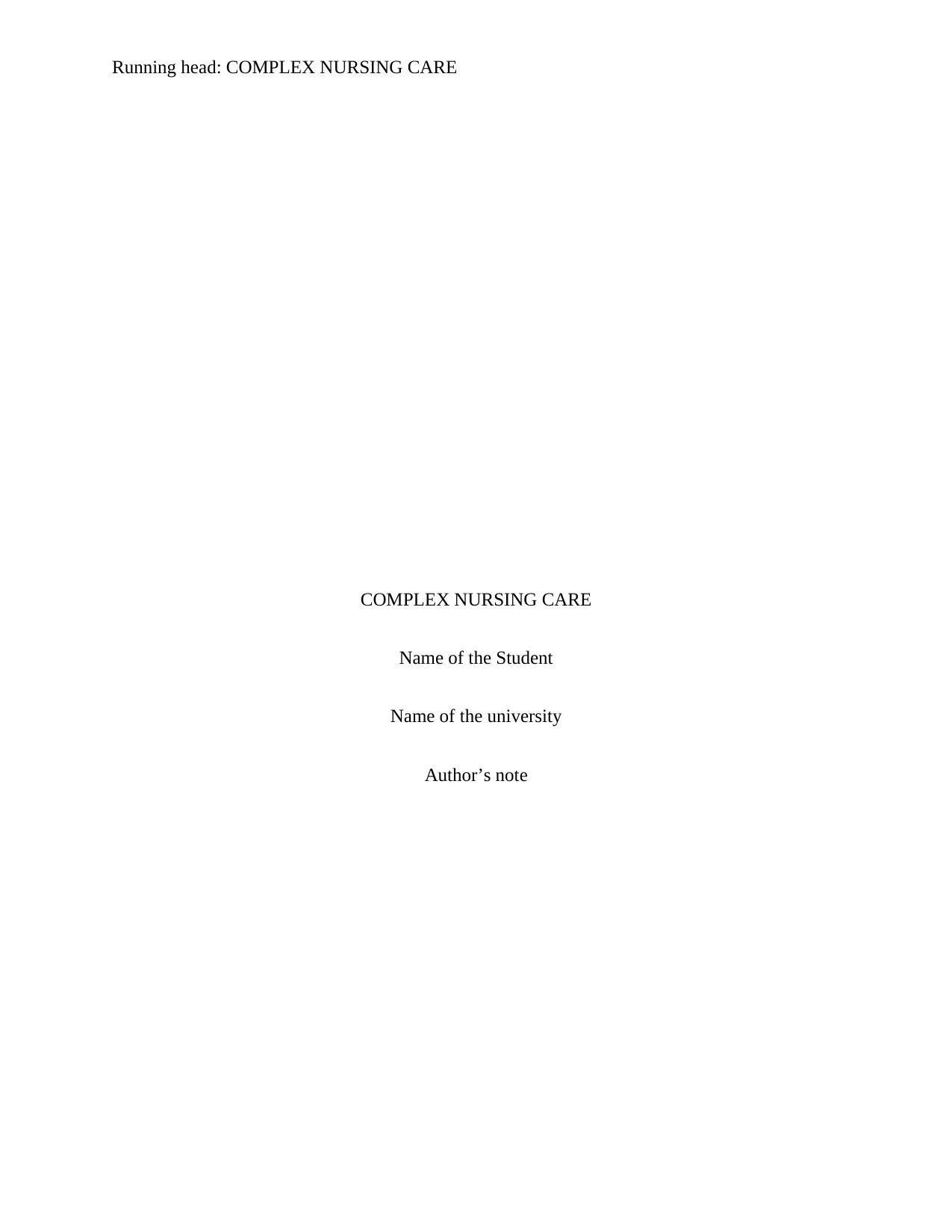
Running head: COMPLEX NURSING CARE
COMPLEX NURSING CARE
Name of the Student
Name of the university
Author’s note
COMPLEX NURSING CARE
Name of the Student
Name of the university
Author’s note
Paraphrase This Document
Need a fresh take? Get an instant paraphrase of this document with our AI Paraphraser
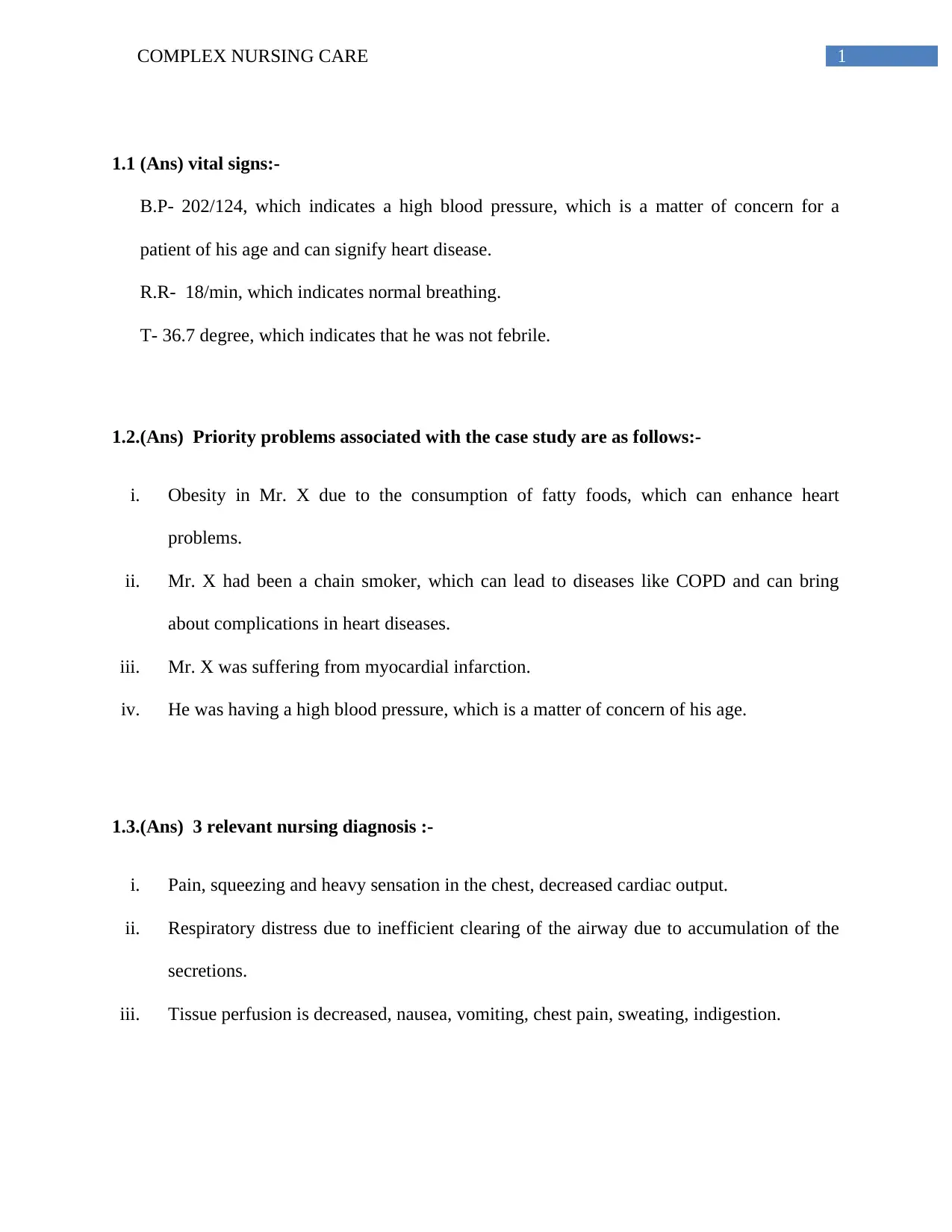
1COMPLEX NURSING CARE
1.1 (Ans) vital signs:-
B.P- 202/124, which indicates a high blood pressure, which is a matter of concern for a
patient of his age and can signify heart disease.
R.R- 18/min, which indicates normal breathing.
T- 36.7 degree, which indicates that he was not febrile.
1.2.(Ans) Priority problems associated with the case study are as follows:-
i. Obesity in Mr. X due to the consumption of fatty foods, which can enhance heart
problems.
ii. Mr. X had been a chain smoker, which can lead to diseases like COPD and can bring
about complications in heart diseases.
iii. Mr. X was suffering from myocardial infarction.
iv. He was having a high blood pressure, which is a matter of concern of his age.
1.3.(Ans) 3 relevant nursing diagnosis :-
i. Pain, squeezing and heavy sensation in the chest, decreased cardiac output.
ii. Respiratory distress due to inefficient clearing of the airway due to accumulation of the
secretions.
iii. Tissue perfusion is decreased, nausea, vomiting, chest pain, sweating, indigestion.
1.1 (Ans) vital signs:-
B.P- 202/124, which indicates a high blood pressure, which is a matter of concern for a
patient of his age and can signify heart disease.
R.R- 18/min, which indicates normal breathing.
T- 36.7 degree, which indicates that he was not febrile.
1.2.(Ans) Priority problems associated with the case study are as follows:-
i. Obesity in Mr. X due to the consumption of fatty foods, which can enhance heart
problems.
ii. Mr. X had been a chain smoker, which can lead to diseases like COPD and can bring
about complications in heart diseases.
iii. Mr. X was suffering from myocardial infarction.
iv. He was having a high blood pressure, which is a matter of concern of his age.
1.3.(Ans) 3 relevant nursing diagnosis :-
i. Pain, squeezing and heavy sensation in the chest, decreased cardiac output.
ii. Respiratory distress due to inefficient clearing of the airway due to accumulation of the
secretions.
iii. Tissue perfusion is decreased, nausea, vomiting, chest pain, sweating, indigestion.
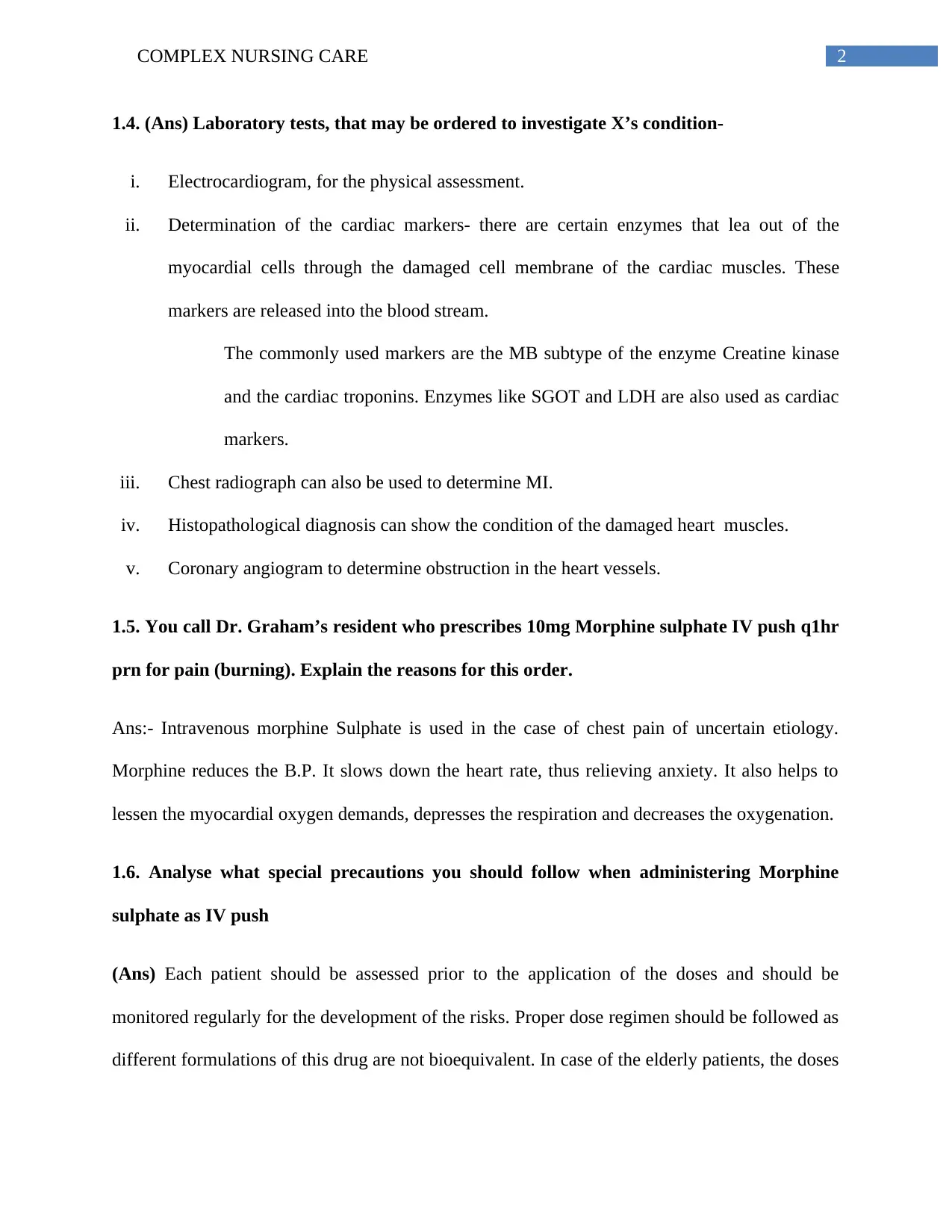
2COMPLEX NURSING CARE
1.4. (Ans) Laboratory tests, that may be ordered to investigate X’s condition-
i. Electrocardiogram, for the physical assessment.
ii. Determination of the cardiac markers- there are certain enzymes that lea out of the
myocardial cells through the damaged cell membrane of the cardiac muscles. These
markers are released into the blood stream.
The commonly used markers are the MB subtype of the enzyme Creatine kinase
and the cardiac troponins. Enzymes like SGOT and LDH are also used as cardiac
markers.
iii. Chest radiograph can also be used to determine MI.
iv. Histopathological diagnosis can show the condition of the damaged heart muscles.
v. Coronary angiogram to determine obstruction in the heart vessels.
1.5. You call Dr. Graham’s resident who prescribes 10mg Morphine sulphate IV push q1hr
prn for pain (burning). Explain the reasons for this order.
Ans:- Intravenous morphine Sulphate is used in the case of chest pain of uncertain etiology.
Morphine reduces the B.P. It slows down the heart rate, thus relieving anxiety. It also helps to
lessen the myocardial oxygen demands, depresses the respiration and decreases the oxygenation.
1.6. Analyse what special precautions you should follow when administering Morphine
sulphate as IV push
(Ans) Each patient should be assessed prior to the application of the doses and should be
monitored regularly for the development of the risks. Proper dose regimen should be followed as
different formulations of this drug are not bioequivalent. In case of the elderly patients, the doses
1.4. (Ans) Laboratory tests, that may be ordered to investigate X’s condition-
i. Electrocardiogram, for the physical assessment.
ii. Determination of the cardiac markers- there are certain enzymes that lea out of the
myocardial cells through the damaged cell membrane of the cardiac muscles. These
markers are released into the blood stream.
The commonly used markers are the MB subtype of the enzyme Creatine kinase
and the cardiac troponins. Enzymes like SGOT and LDH are also used as cardiac
markers.
iii. Chest radiograph can also be used to determine MI.
iv. Histopathological diagnosis can show the condition of the damaged heart muscles.
v. Coronary angiogram to determine obstruction in the heart vessels.
1.5. You call Dr. Graham’s resident who prescribes 10mg Morphine sulphate IV push q1hr
prn for pain (burning). Explain the reasons for this order.
Ans:- Intravenous morphine Sulphate is used in the case of chest pain of uncertain etiology.
Morphine reduces the B.P. It slows down the heart rate, thus relieving anxiety. It also helps to
lessen the myocardial oxygen demands, depresses the respiration and decreases the oxygenation.
1.6. Analyse what special precautions you should follow when administering Morphine
sulphate as IV push
(Ans) Each patient should be assessed prior to the application of the doses and should be
monitored regularly for the development of the risks. Proper dose regimen should be followed as
different formulations of this drug are not bioequivalent. In case of the elderly patients, the doses
⊘ This is a preview!⊘
Do you want full access?
Subscribe today to unlock all pages.

Trusted by 1+ million students worldwide
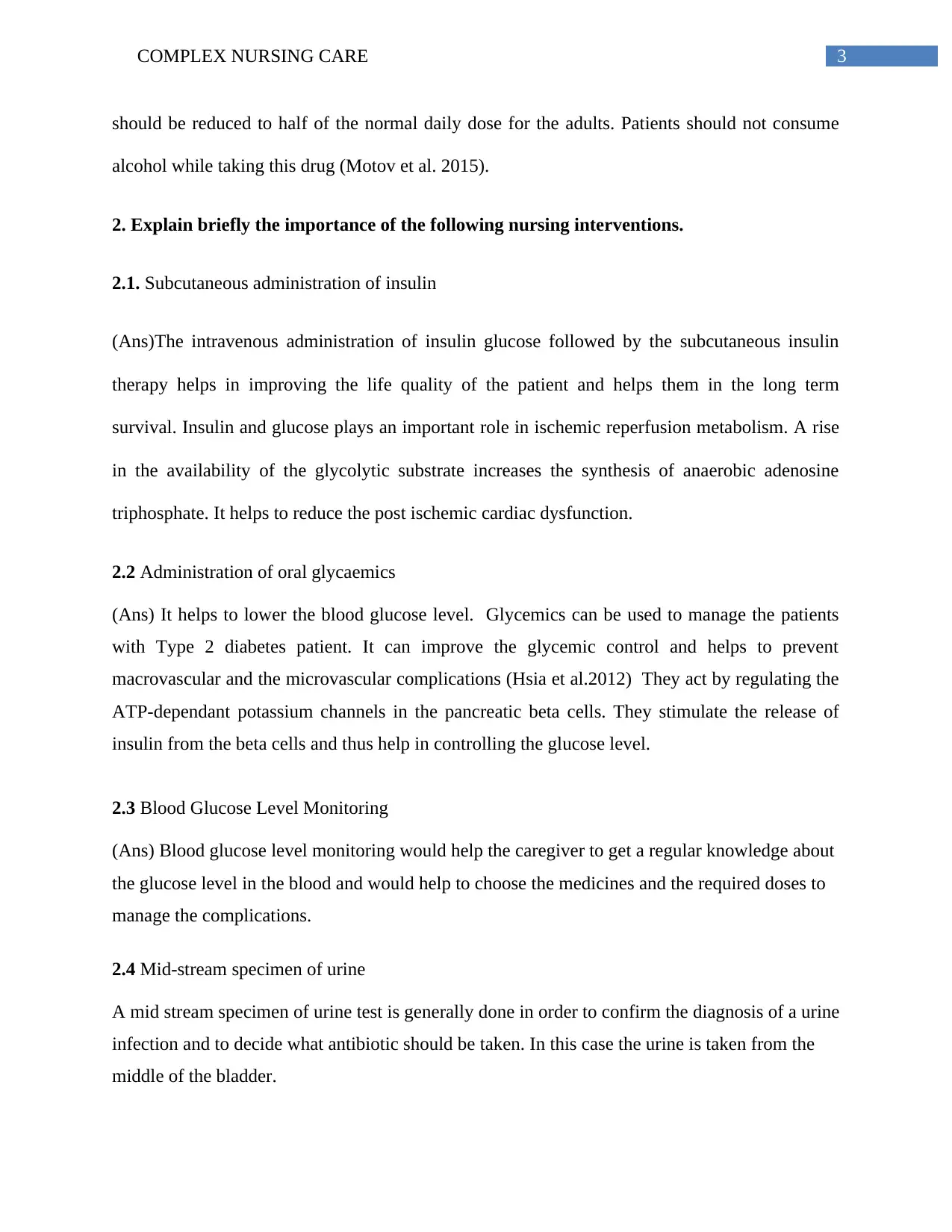
3COMPLEX NURSING CARE
should be reduced to half of the normal daily dose for the adults. Patients should not consume
alcohol while taking this drug (Motov et al. 2015).
2. Explain briefly the importance of the following nursing interventions.
2.1. Subcutaneous administration of insulin
(Ans)The intravenous administration of insulin glucose followed by the subcutaneous insulin
therapy helps in improving the life quality of the patient and helps them in the long term
survival. Insulin and glucose plays an important role in ischemic reperfusion metabolism. A rise
in the availability of the glycolytic substrate increases the synthesis of anaerobic adenosine
triphosphate. It helps to reduce the post ischemic cardiac dysfunction.
2.2 Administration of oral glycaemics
(Ans) It helps to lower the blood glucose level. Glycemics can be used to manage the patients
with Type 2 diabetes patient. It can improve the glycemic control and helps to prevent
macrovascular and the microvascular complications (Hsia et al.2012) They act by regulating the
ATP-dependant potassium channels in the pancreatic beta cells. They stimulate the release of
insulin from the beta cells and thus help in controlling the glucose level.
2.3 Blood Glucose Level Monitoring
(Ans) Blood glucose level monitoring would help the caregiver to get a regular knowledge about
the glucose level in the blood and would help to choose the medicines and the required doses to
manage the complications.
2.4 Mid-stream specimen of urine
A mid stream specimen of urine test is generally done in order to confirm the diagnosis of a urine
infection and to decide what antibiotic should be taken. In this case the urine is taken from the
middle of the bladder.
should be reduced to half of the normal daily dose for the adults. Patients should not consume
alcohol while taking this drug (Motov et al. 2015).
2. Explain briefly the importance of the following nursing interventions.
2.1. Subcutaneous administration of insulin
(Ans)The intravenous administration of insulin glucose followed by the subcutaneous insulin
therapy helps in improving the life quality of the patient and helps them in the long term
survival. Insulin and glucose plays an important role in ischemic reperfusion metabolism. A rise
in the availability of the glycolytic substrate increases the synthesis of anaerobic adenosine
triphosphate. It helps to reduce the post ischemic cardiac dysfunction.
2.2 Administration of oral glycaemics
(Ans) It helps to lower the blood glucose level. Glycemics can be used to manage the patients
with Type 2 diabetes patient. It can improve the glycemic control and helps to prevent
macrovascular and the microvascular complications (Hsia et al.2012) They act by regulating the
ATP-dependant potassium channels in the pancreatic beta cells. They stimulate the release of
insulin from the beta cells and thus help in controlling the glucose level.
2.3 Blood Glucose Level Monitoring
(Ans) Blood glucose level monitoring would help the caregiver to get a regular knowledge about
the glucose level in the blood and would help to choose the medicines and the required doses to
manage the complications.
2.4 Mid-stream specimen of urine
A mid stream specimen of urine test is generally done in order to confirm the diagnosis of a urine
infection and to decide what antibiotic should be taken. In this case the urine is taken from the
middle of the bladder.
Paraphrase This Document
Need a fresh take? Get an instant paraphrase of this document with our AI Paraphraser
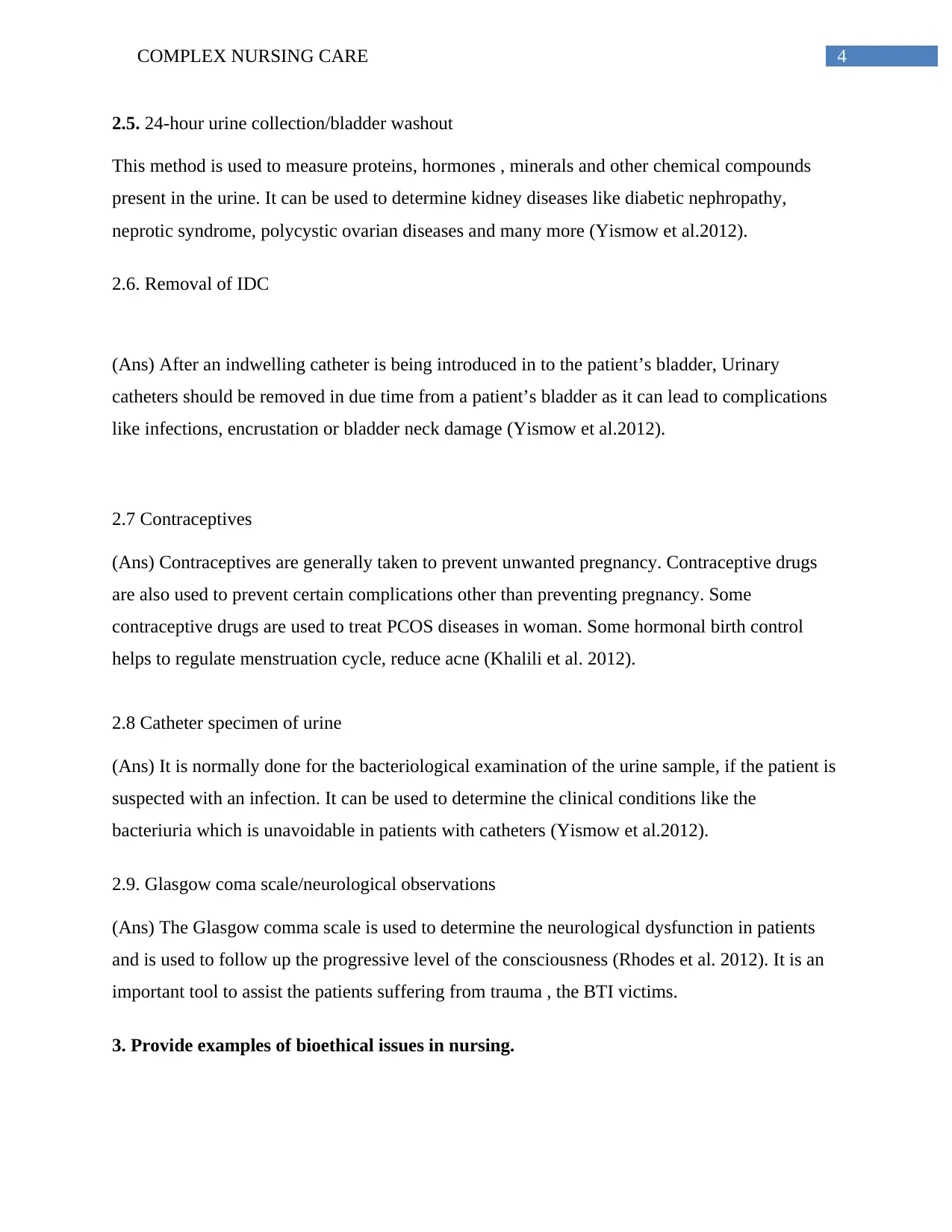
4COMPLEX NURSING CARE
2.5. 24-hour urine collection/bladder washout
This method is used to measure proteins, hormones , minerals and other chemical compounds
present in the urine. It can be used to determine kidney diseases like diabetic nephropathy,
neprotic syndrome, polycystic ovarian diseases and many more (Yismow et al.2012).
2.6. Removal of IDC
(Ans) After an indwelling catheter is being introduced in to the patient’s bladder, Urinary
catheters should be removed in due time from a patient’s bladder as it can lead to complications
like infections, encrustation or bladder neck damage (Yismow et al.2012).
2.7 Contraceptives
(Ans) Contraceptives are generally taken to prevent unwanted pregnancy. Contraceptive drugs
are also used to prevent certain complications other than preventing pregnancy. Some
contraceptive drugs are used to treat PCOS diseases in woman. Some hormonal birth control
helps to regulate menstruation cycle, reduce acne (Khalili et al. 2012).
2.8 Catheter specimen of urine
(Ans) It is normally done for the bacteriological examination of the urine sample, if the patient is
suspected with an infection. It can be used to determine the clinical conditions like the
bacteriuria which is unavoidable in patients with catheters (Yismow et al.2012).
2.9. Glasgow coma scale/neurological observations
(Ans) The Glasgow comma scale is used to determine the neurological dysfunction in patients
and is used to follow up the progressive level of the consciousness (Rhodes et al. 2012). It is an
important tool to assist the patients suffering from trauma , the BTI victims.
3. Provide examples of bioethical issues in nursing.
2.5. 24-hour urine collection/bladder washout
This method is used to measure proteins, hormones , minerals and other chemical compounds
present in the urine. It can be used to determine kidney diseases like diabetic nephropathy,
neprotic syndrome, polycystic ovarian diseases and many more (Yismow et al.2012).
2.6. Removal of IDC
(Ans) After an indwelling catheter is being introduced in to the patient’s bladder, Urinary
catheters should be removed in due time from a patient’s bladder as it can lead to complications
like infections, encrustation or bladder neck damage (Yismow et al.2012).
2.7 Contraceptives
(Ans) Contraceptives are generally taken to prevent unwanted pregnancy. Contraceptive drugs
are also used to prevent certain complications other than preventing pregnancy. Some
contraceptive drugs are used to treat PCOS diseases in woman. Some hormonal birth control
helps to regulate menstruation cycle, reduce acne (Khalili et al. 2012).
2.8 Catheter specimen of urine
(Ans) It is normally done for the bacteriological examination of the urine sample, if the patient is
suspected with an infection. It can be used to determine the clinical conditions like the
bacteriuria which is unavoidable in patients with catheters (Yismow et al.2012).
2.9. Glasgow coma scale/neurological observations
(Ans) The Glasgow comma scale is used to determine the neurological dysfunction in patients
and is used to follow up the progressive level of the consciousness (Rhodes et al. 2012). It is an
important tool to assist the patients suffering from trauma , the BTI victims.
3. Provide examples of bioethical issues in nursing.
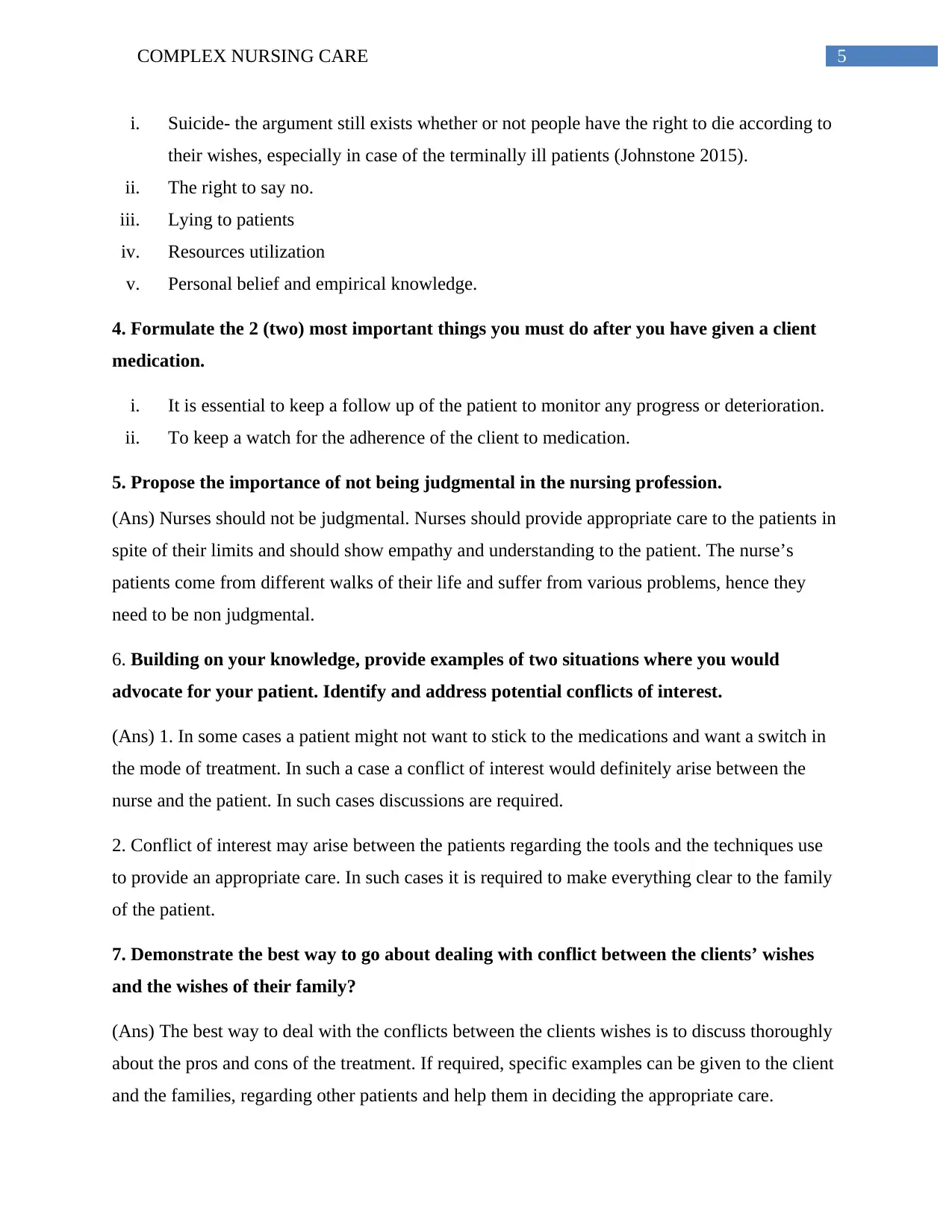
5COMPLEX NURSING CARE
i. Suicide- the argument still exists whether or not people have the right to die according to
their wishes, especially in case of the terminally ill patients (Johnstone 2015).
ii. The right to say no.
iii. Lying to patients
iv. Resources utilization
v. Personal belief and empirical knowledge.
4. Formulate the 2 (two) most important things you must do after you have given a client
medication.
i. It is essential to keep a follow up of the patient to monitor any progress or deterioration.
ii. To keep a watch for the adherence of the client to medication.
5. Propose the importance of not being judgmental in the nursing profession.
(Ans) Nurses should not be judgmental. Nurses should provide appropriate care to the patients in
spite of their limits and should show empathy and understanding to the patient. The nurse’s
patients come from different walks of their life and suffer from various problems, hence they
need to be non judgmental.
6. Building on your knowledge, provide examples of two situations where you would
advocate for your patient. Identify and address potential conflicts of interest.
(Ans) 1. In some cases a patient might not want to stick to the medications and want a switch in
the mode of treatment. In such a case a conflict of interest would definitely arise between the
nurse and the patient. In such cases discussions are required.
2. Conflict of interest may arise between the patients regarding the tools and the techniques use
to provide an appropriate care. In such cases it is required to make everything clear to the family
of the patient.
7. Demonstrate the best way to go about dealing with conflict between the clients’ wishes
and the wishes of their family?
(Ans) The best way to deal with the conflicts between the clients wishes is to discuss thoroughly
about the pros and cons of the treatment. If required, specific examples can be given to the client
and the families, regarding other patients and help them in deciding the appropriate care.
i. Suicide- the argument still exists whether or not people have the right to die according to
their wishes, especially in case of the terminally ill patients (Johnstone 2015).
ii. The right to say no.
iii. Lying to patients
iv. Resources utilization
v. Personal belief and empirical knowledge.
4. Formulate the 2 (two) most important things you must do after you have given a client
medication.
i. It is essential to keep a follow up of the patient to monitor any progress or deterioration.
ii. To keep a watch for the adherence of the client to medication.
5. Propose the importance of not being judgmental in the nursing profession.
(Ans) Nurses should not be judgmental. Nurses should provide appropriate care to the patients in
spite of their limits and should show empathy and understanding to the patient. The nurse’s
patients come from different walks of their life and suffer from various problems, hence they
need to be non judgmental.
6. Building on your knowledge, provide examples of two situations where you would
advocate for your patient. Identify and address potential conflicts of interest.
(Ans) 1. In some cases a patient might not want to stick to the medications and want a switch in
the mode of treatment. In such a case a conflict of interest would definitely arise between the
nurse and the patient. In such cases discussions are required.
2. Conflict of interest may arise between the patients regarding the tools and the techniques use
to provide an appropriate care. In such cases it is required to make everything clear to the family
of the patient.
7. Demonstrate the best way to go about dealing with conflict between the clients’ wishes
and the wishes of their family?
(Ans) The best way to deal with the conflicts between the clients wishes is to discuss thoroughly
about the pros and cons of the treatment. If required, specific examples can be given to the client
and the families, regarding other patients and help them in deciding the appropriate care.
⊘ This is a preview!⊘
Do you want full access?
Subscribe today to unlock all pages.

Trusted by 1+ million students worldwide
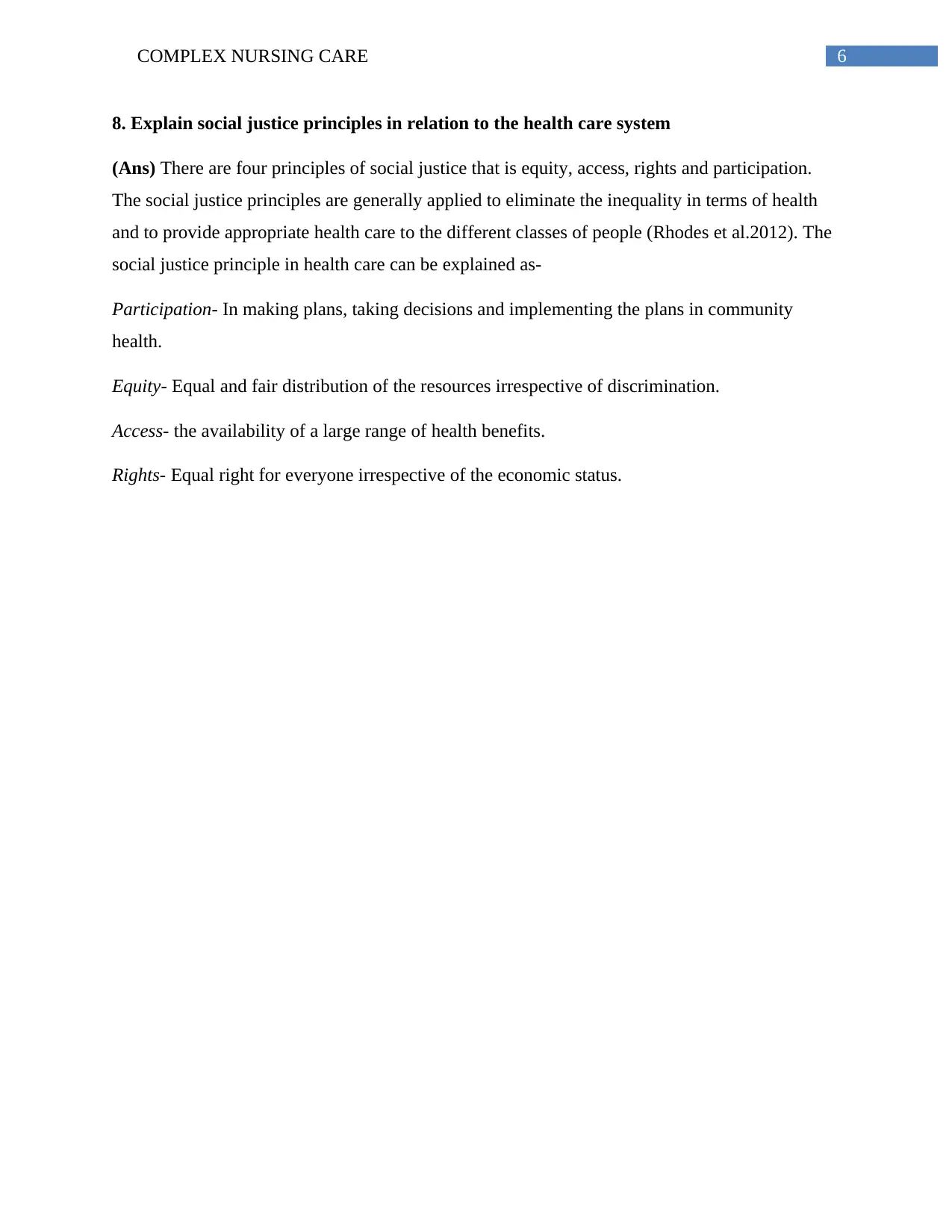
6COMPLEX NURSING CARE
8. Explain social justice principles in relation to the health care system
(Ans) There are four principles of social justice that is equity, access, rights and participation.
The social justice principles are generally applied to eliminate the inequality in terms of health
and to provide appropriate health care to the different classes of people (Rhodes et al.2012). The
social justice principle in health care can be explained as-
Participation- In making plans, taking decisions and implementing the plans in community
health.
Equity- Equal and fair distribution of the resources irrespective of discrimination.
Access- the availability of a large range of health benefits.
Rights- Equal right for everyone irrespective of the economic status.
8. Explain social justice principles in relation to the health care system
(Ans) There are four principles of social justice that is equity, access, rights and participation.
The social justice principles are generally applied to eliminate the inequality in terms of health
and to provide appropriate health care to the different classes of people (Rhodes et al.2012). The
social justice principle in health care can be explained as-
Participation- In making plans, taking decisions and implementing the plans in community
health.
Equity- Equal and fair distribution of the resources irrespective of discrimination.
Access- the availability of a large range of health benefits.
Rights- Equal right for everyone irrespective of the economic status.
Paraphrase This Document
Need a fresh take? Get an instant paraphrase of this document with our AI Paraphraser
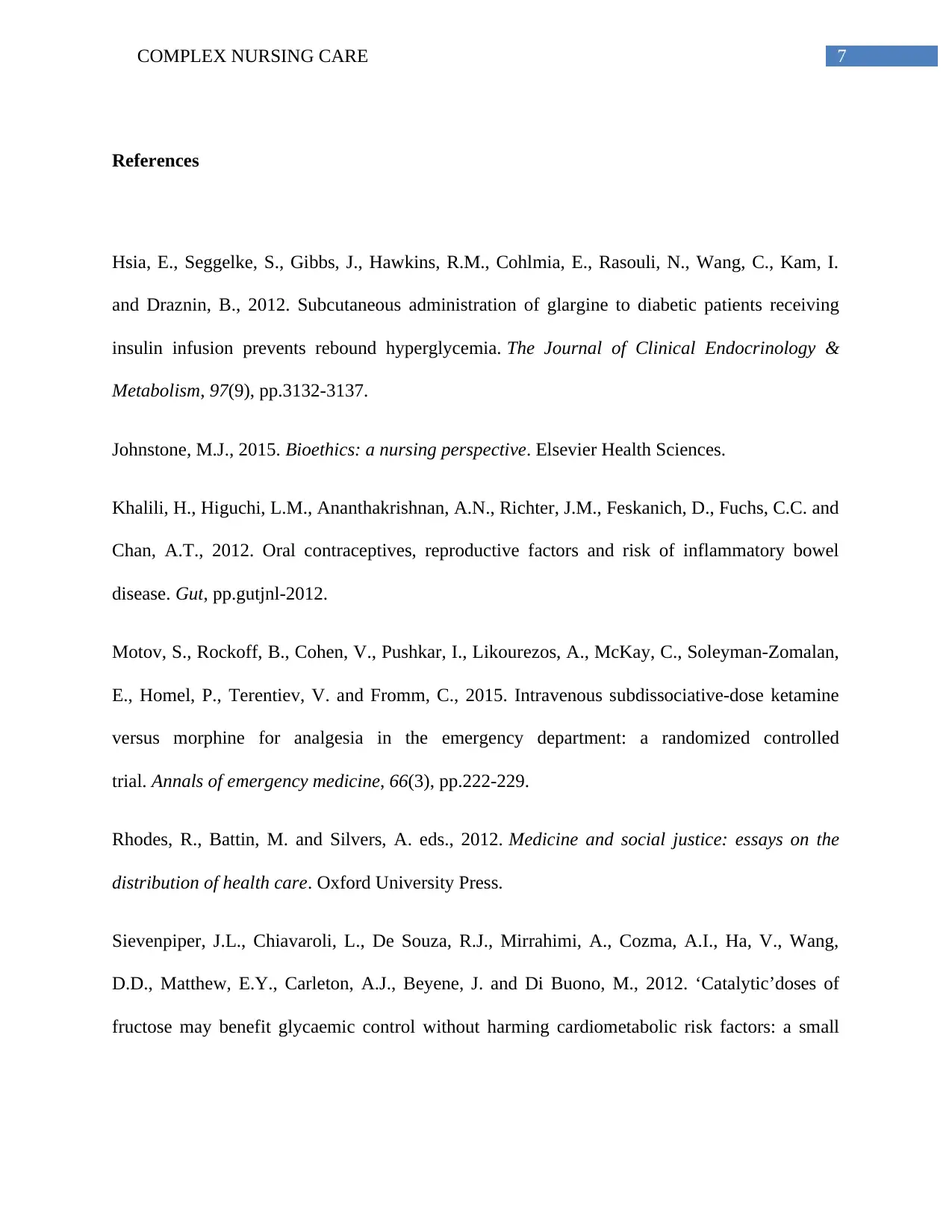
7COMPLEX NURSING CARE
References
Hsia, E., Seggelke, S., Gibbs, J., Hawkins, R.M., Cohlmia, E., Rasouli, N., Wang, C., Kam, I.
and Draznin, B., 2012. Subcutaneous administration of glargine to diabetic patients receiving
insulin infusion prevents rebound hyperglycemia. The Journal of Clinical Endocrinology &
Metabolism, 97(9), pp.3132-3137.
Johnstone, M.J., 2015. Bioethics: a nursing perspective. Elsevier Health Sciences.
Khalili, H., Higuchi, L.M., Ananthakrishnan, A.N., Richter, J.M., Feskanich, D., Fuchs, C.C. and
Chan, A.T., 2012. Oral contraceptives, reproductive factors and risk of inflammatory bowel
disease. Gut, pp.gutjnl-2012.
Motov, S., Rockoff, B., Cohen, V., Pushkar, I., Likourezos, A., McKay, C., Soleyman-Zomalan,
E., Homel, P., Terentiev, V. and Fromm, C., 2015. Intravenous subdissociative-dose ketamine
versus morphine for analgesia in the emergency department: a randomized controlled
trial. Annals of emergency medicine, 66(3), pp.222-229.
Rhodes, R., Battin, M. and Silvers, A. eds., 2012. Medicine and social justice: essays on the
distribution of health care. Oxford University Press.
Sievenpiper, J.L., Chiavaroli, L., De Souza, R.J., Mirrahimi, A., Cozma, A.I., Ha, V., Wang,
D.D., Matthew, E.Y., Carleton, A.J., Beyene, J. and Di Buono, M., 2012. ‘Catalytic’doses of
fructose may benefit glycaemic control without harming cardiometabolic risk factors: a small
References
Hsia, E., Seggelke, S., Gibbs, J., Hawkins, R.M., Cohlmia, E., Rasouli, N., Wang, C., Kam, I.
and Draznin, B., 2012. Subcutaneous administration of glargine to diabetic patients receiving
insulin infusion prevents rebound hyperglycemia. The Journal of Clinical Endocrinology &
Metabolism, 97(9), pp.3132-3137.
Johnstone, M.J., 2015. Bioethics: a nursing perspective. Elsevier Health Sciences.
Khalili, H., Higuchi, L.M., Ananthakrishnan, A.N., Richter, J.M., Feskanich, D., Fuchs, C.C. and
Chan, A.T., 2012. Oral contraceptives, reproductive factors and risk of inflammatory bowel
disease. Gut, pp.gutjnl-2012.
Motov, S., Rockoff, B., Cohen, V., Pushkar, I., Likourezos, A., McKay, C., Soleyman-Zomalan,
E., Homel, P., Terentiev, V. and Fromm, C., 2015. Intravenous subdissociative-dose ketamine
versus morphine for analgesia in the emergency department: a randomized controlled
trial. Annals of emergency medicine, 66(3), pp.222-229.
Rhodes, R., Battin, M. and Silvers, A. eds., 2012. Medicine and social justice: essays on the
distribution of health care. Oxford University Press.
Sievenpiper, J.L., Chiavaroli, L., De Souza, R.J., Mirrahimi, A., Cozma, A.I., Ha, V., Wang,
D.D., Matthew, E.Y., Carleton, A.J., Beyene, J. and Di Buono, M., 2012. ‘Catalytic’doses of
fructose may benefit glycaemic control without harming cardiometabolic risk factors: a small
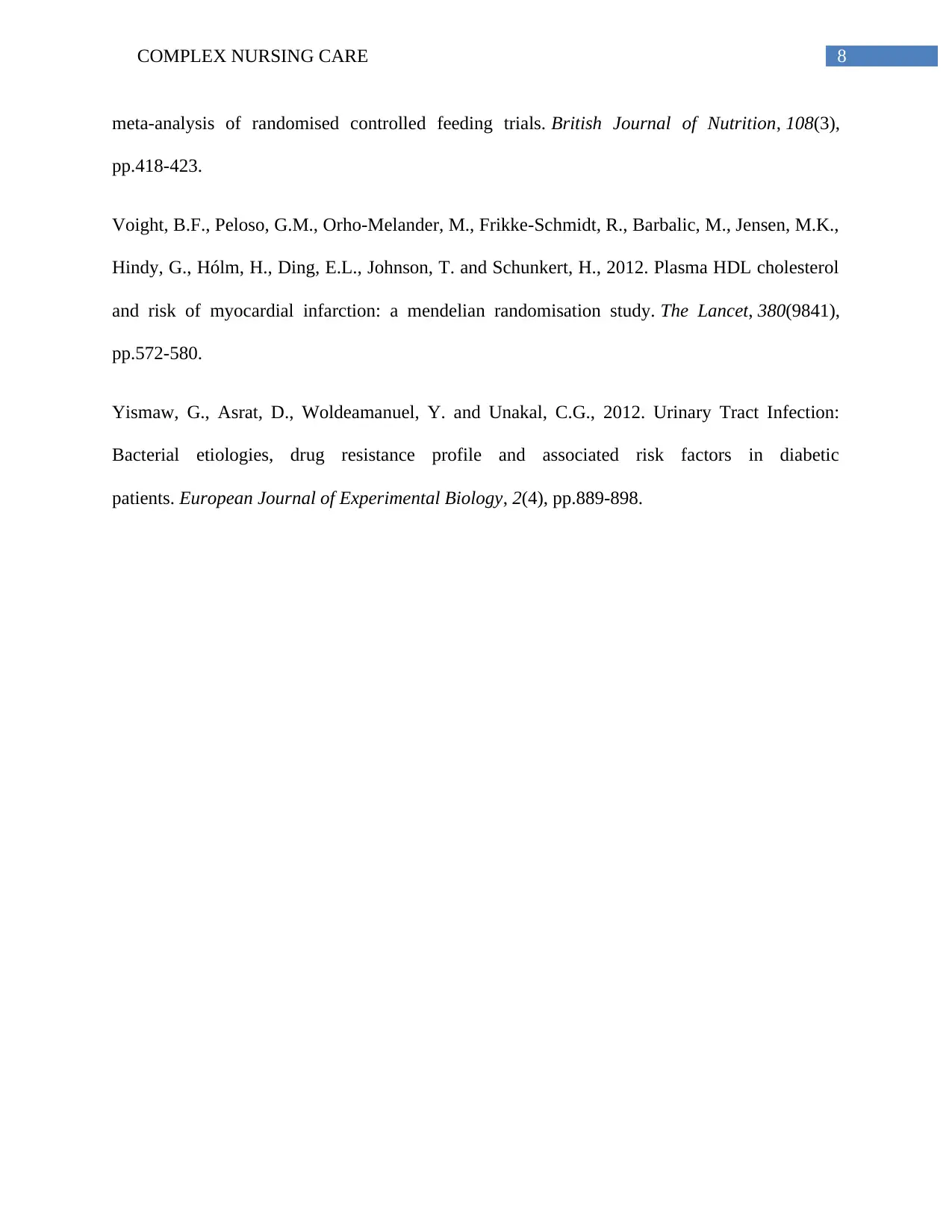
8COMPLEX NURSING CARE
meta-analysis of randomised controlled feeding trials. British Journal of Nutrition, 108(3),
pp.418-423.
Voight, B.F., Peloso, G.M., Orho-Melander, M., Frikke-Schmidt, R., Barbalic, M., Jensen, M.K.,
Hindy, G., Hólm, H., Ding, E.L., Johnson, T. and Schunkert, H., 2012. Plasma HDL cholesterol
and risk of myocardial infarction: a mendelian randomisation study. The Lancet, 380(9841),
pp.572-580.
Yismaw, G., Asrat, D., Woldeamanuel, Y. and Unakal, C.G., 2012. Urinary Tract Infection:
Bacterial etiologies, drug resistance profile and associated risk factors in diabetic
patients. European Journal of Experimental Biology, 2(4), pp.889-898.
meta-analysis of randomised controlled feeding trials. British Journal of Nutrition, 108(3),
pp.418-423.
Voight, B.F., Peloso, G.M., Orho-Melander, M., Frikke-Schmidt, R., Barbalic, M., Jensen, M.K.,
Hindy, G., Hólm, H., Ding, E.L., Johnson, T. and Schunkert, H., 2012. Plasma HDL cholesterol
and risk of myocardial infarction: a mendelian randomisation study. The Lancet, 380(9841),
pp.572-580.
Yismaw, G., Asrat, D., Woldeamanuel, Y. and Unakal, C.G., 2012. Urinary Tract Infection:
Bacterial etiologies, drug resistance profile and associated risk factors in diabetic
patients. European Journal of Experimental Biology, 2(4), pp.889-898.
⊘ This is a preview!⊘
Do you want full access?
Subscribe today to unlock all pages.

Trusted by 1+ million students worldwide
1 out of 9
Related Documents
Your All-in-One AI-Powered Toolkit for Academic Success.
+13062052269
info@desklib.com
Available 24*7 on WhatsApp / Email
![[object Object]](/_next/static/media/star-bottom.7253800d.svg)
Unlock your academic potential
Copyright © 2020–2025 A2Z Services. All Rights Reserved. Developed and managed by ZUCOL.





